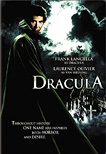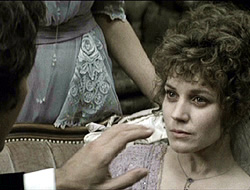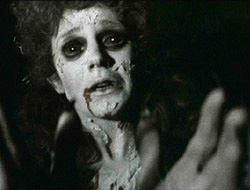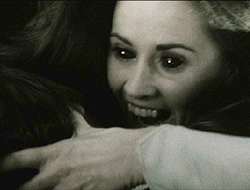|
|

Universal Studios' return to the Dracula property in 1979 was inspired by Frank Langella's starmaking performance as the Count in a Broadway revival of the Deane/Balderston play (the same play that largely inspired Universal's original 1931 Dracula), featuring sets designed by the great Edward Gorey. Langella's take on the role is justly celebrated, but unfortunately, the film that was cobbled around him is a rather shaky affair at best.
Adaptation
The action commences with Dracula's arrival on a shipwreck on the
Whitby coast during a titanic storm. There, Mina (daughter of Van Helsing
in this version) is staying with Lucy (daughter of Dr. Seward in this
version) in a residence above the lunatic asylum that Seward runs. Mina is
an invalid (though not a sleepwalker) and looks half-dead even before the
Count arrives. When not assisting her father in the Bedlamite asylum,
where grotesque but irrelevant characters cavort on steel ramps high in
the air, Lucy likes to make out in the greenhouse with her fiancee
Jonathan Harker, a rather creepy fellow who looks like a rat with a
Beatles haircut. Their idylls are sadly interrupted by the arrival of the
Count, who, tall, dark, and (literally) hypnotic, quickly establishes his
thrall over the ladies of the house, much to Harker's disgust. Mina's
death brings the arrival of Dr. Van Helsing (Lawrence Olivier), who has a
big moustache, a quaint little accent, and an affinity for garlic. After
dispatching his own daughter Mina in caves beneath the cemetary, Van
Helsing and Harker face the more difficult task of saving Lucy, who is
besotted with the Count and more than a little toothy herself.
The changes in the story in this version seem to fall into two major categories: The usual need to compress the plot to movie length, and the desire to play up Dracula as more attractive than horrific. Perhaps in compensation, the other characters in the story are all craven, selfish, imbecilic, pathetic or simply bizarre. For example, Dr. Seward in this version is perhaps the world's most insenstive person, gleefully chowing down on breakfast goodies without concern for the recent death of Mina. And Renfield is just a sloppy fellow with a taste for bugs.
Vampire Lore
Dracula in this version has powers to transform into bat or wolf, to
climb sheer walls, and to mesmerize others and dominate their will. He is
invisible in mirrors and greatly averse to garlic, though the crucifix
proves an unreliable weapon against him: Dracula causes Harker's wooden
crucifix to burst into flames! He rides abroad at twilight, and moves
freely in caves during the day, but suffers horrible burns when exposed to
direct sunlight.
Visuals
The greatest strength of the production, aside from Langella's
performance, is the visual design work. Dracula's lair at Carfax Abbey is
quite richly imagined, though perhaps a little over the top. Director John
Badham devised many shots for the film that are cleverly imagined, such as
one where Lucy's arrival at the Abbey is viewed from above through a web
with a huge spider crawling above her. Similar conceits pop up elsewhere,
as when Lucy is viewed from above through steel mesh gratings at the
asylum, or with crossed shadows on her face from the bars of a
window.
Palette
Problems
In the audio commentary on the DVD, Badham comments that he originally
wanted a "19th century engraving" look to the film, but budget
and technology of the time did not make it possible. For this DVD release,
he used more modern techniques to drain almost all the color from the
picture, and to skew what remains toward bluish-green. To my eye, the
effect just makes it look like there's something wrong with your TV set.
Hopefully a version with the original color scheme will become available
again someday.







